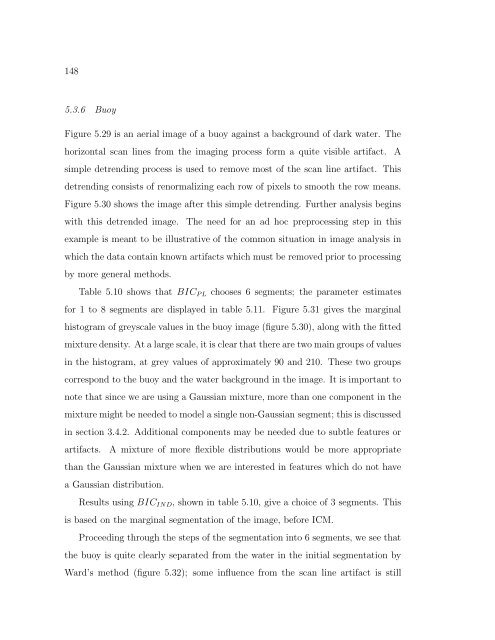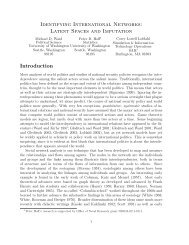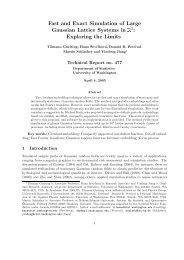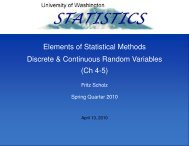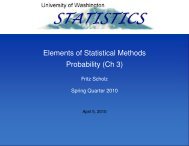View - Statistics - University of Washington
View - Statistics - University of Washington
View - Statistics - University of Washington
Create successful ePaper yourself
Turn your PDF publications into a flip-book with our unique Google optimized e-Paper software.
1485.3.6 BuoyFigure 5.29 is an aerial image <strong>of</strong> a buoy against a background <strong>of</strong> dark water. Thehorizontal scan lines from the imaging process form a quite visible artifact. Asimple detrending process is used to remove most <strong>of</strong> the scan line artifact. Thisdetrending consists <strong>of</strong> renormalizing each row <strong>of</strong> pixels to smooth the row means.Figure 5.30 shows the image after this simple detrending. Further analysis beginswith this detrended image. The need for an ad hoc preprocessing step in thisexample is meant to be illustrative <strong>of</strong> the common situation in image analysis inwhich the data contain known artifacts which must be removed prior to processingby more general methods.Table 5.10 shows that BIC P L chooses 6 segments; the parameter estimatesfor 1 to 8 segments are displayed in table 5.11. Figure 5.31 gives the marginalhistogram <strong>of</strong> greyscale values in the buoy image (figure 5.30), along with the fittedmixture density. At a large scale, it is clear that there are two main groups <strong>of</strong> valuesin the histogram, at grey values <strong>of</strong> approximately 90 and 210. These two groupscorrespond to the buoy and the water background in the image. It is important tonote that since we are using a Gaussian mixture, more than one component in themixture might be needed to model a single non-Gaussian segment; this is discussedin section 3.4.2. Additional components may be needed due to subtle features orartifacts. A mixture <strong>of</strong> more flexible distributions would be more appropriatethan the Gaussian mixture when we are interested in features which do not havea Gaussian distribution.Results using BIC IND , shown in table 5.10, give a choice <strong>of</strong> 3 segments. Thisis based on the marginal segmentation <strong>of</strong> the image, before ICM.Proceeding through the steps <strong>of</strong> the segmentation into 6 segments, we see thatthe buoy is quite clearly separated from the water in the initial segmentation byWard’s method (figure 5.32); some influence from the scan line artifact is still


